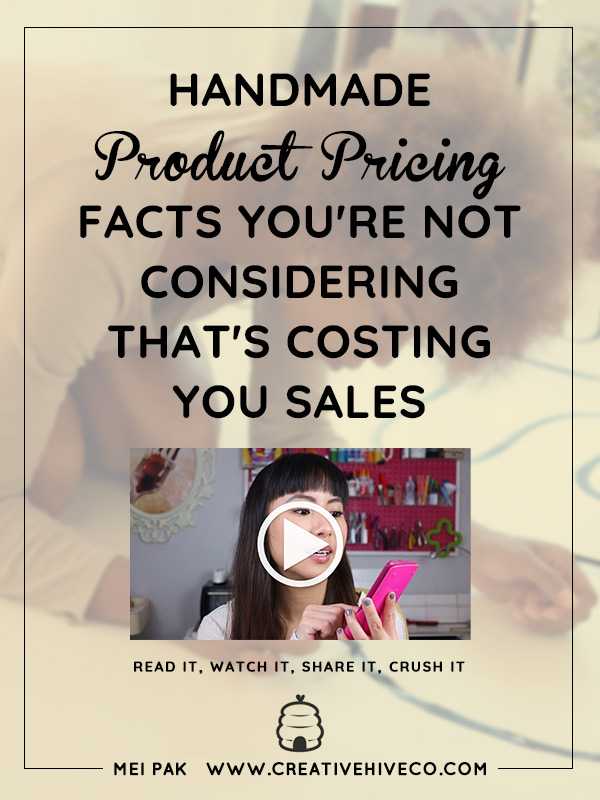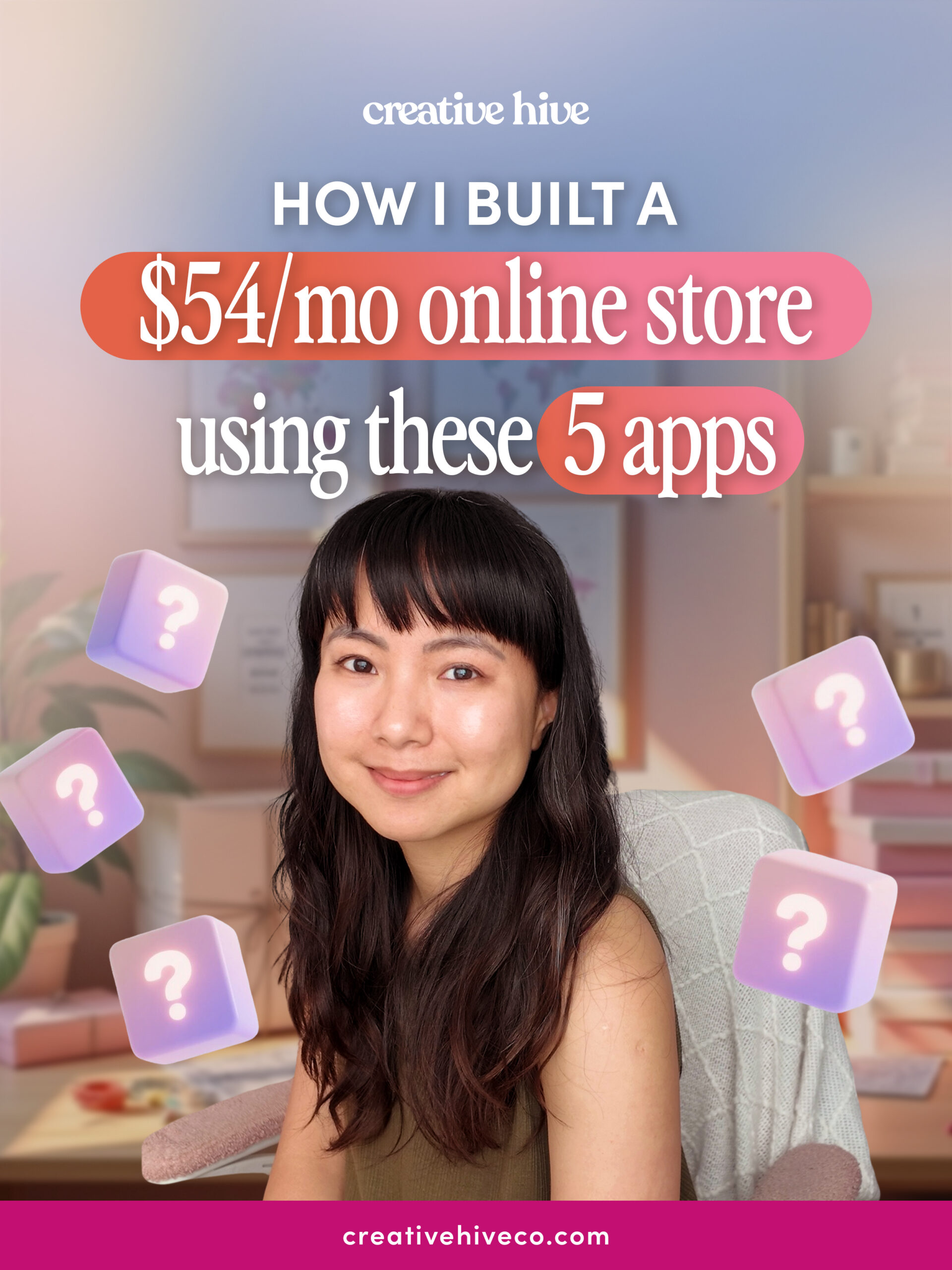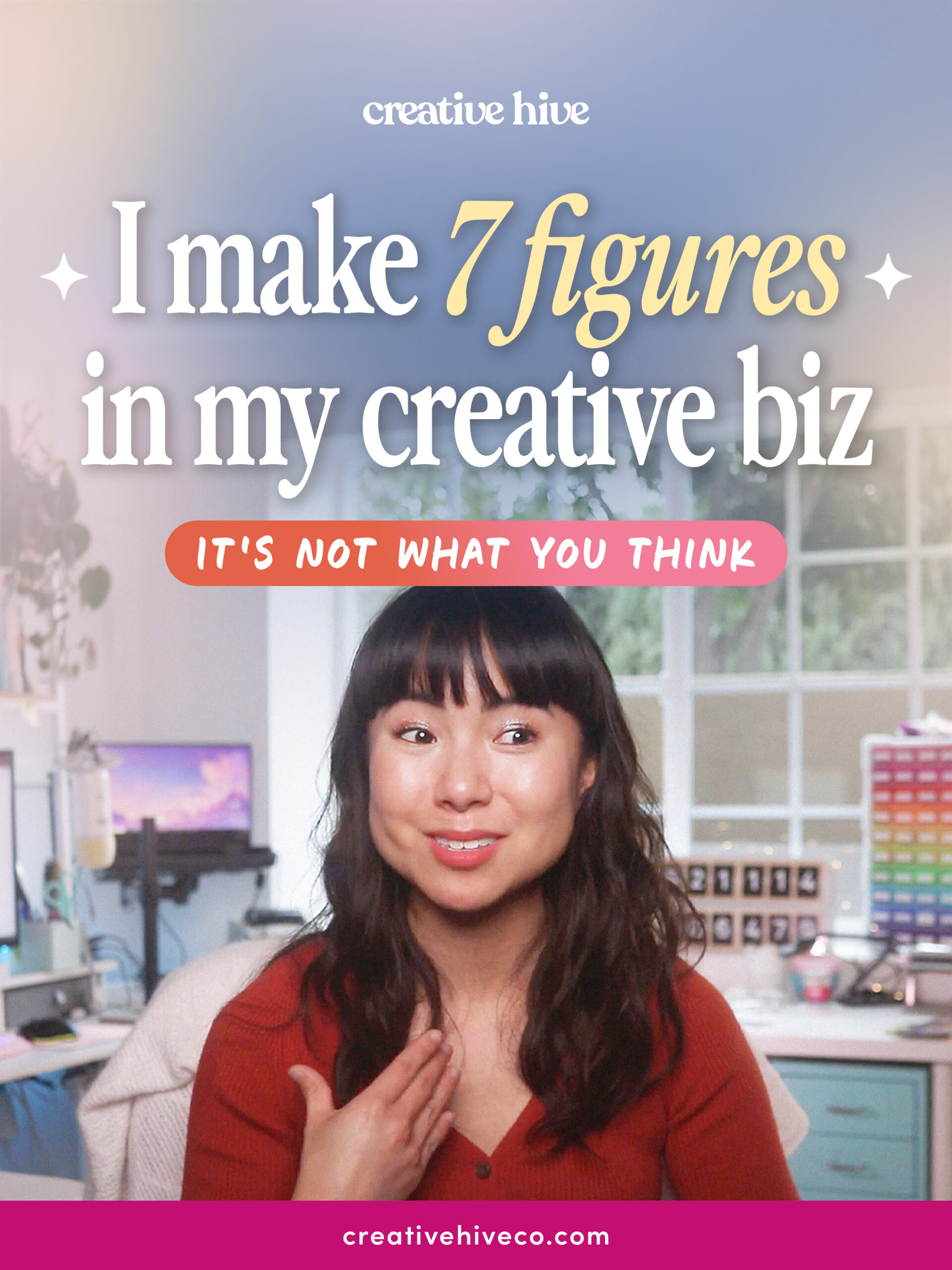Handmade Product Pricing Facts You’re NOT Considering That Are Costing You Sales
I want to help you build a sustainable, profitable handmade business that makes you consistent income and sales. I only ever teach or recommend marketing, social media, pricing, production and branding tips that I’ve personally used successfully in my own 7-figure handmade businesses.
I'm Mei, from Los Angeles!
Read More
Popular Posts You'll Love
Looking for something?
Categories
starting a business
get more traffic
running a business
make more sales
branding
growing a business
mindset & productivity
podcasts
pricing & money
product photography
reviews
selling on etsy
selling on amazon
social media
selling wholesale
- Facebook0
- Twitter0
- Pinterest21
- 21shares
Pricing your handmade products is part art, part science.
The science part is easy to follow, but the art of it can be dangerous if you’re not thinking about it correctly.
Read this post to learn more about some handmade product pricing facts you’re NOT considering that’s costing you sales in your handmade business.
If you’re new to me, you probably don’t know this about me but I went to college for a math degree.
Numbers and I are very comfortable.
Now, before I freak you out, math is only really helpful for the science part of business. If you’re not good at math, don’t worry, you don’t have to be in order to have success with your business.
What we’re going to cover today is more of the art side of things.
Material Costs
Let’s start with the first thing you’re not considering when you’re pricing your product, and that’s with your material costs.
This is something I’ve seen very few people consider, especially if you happen to be a newer business owner.
Your journey was probably something like this – you’ve either been crafting your whole life, or maybe recently you signed up for a class and you fell in love with making jewelry, and you bought some supplies for your project at the craft store. Maybe you went to Michael’s, Joanns, online on Amazon.
So you’re interested in starting your own shop and following my pricing formula. At this point, you’ve bought your materials at retail pricing, but what you need to consider is using prices for your materials as close to wholesale prices as much as possible.
If you’re not sure you understand the difference between retail and wholesale pricing, you first have to understand how your materials got into your hands in the first place.
It all starts with getting them manufactured in a factory. These manufacturers don’t usually sell their products direct to consumer. There’s no store you can walk into and walk out with just one packet of eye pins. There’s no online website you can go to to buy just one bottle of acrylic craft paint.
Manufacturers aren’t selling their products to you or me, they sell them to distributors or wholesalers who then sell them to the end consumer.
Those distributors and wholesalers are the middle man that gets to buy the products from the manufacturers at a very, very low cost. When the distributor sells them to retail stores or to consumers, they mark up the price a bit so they can make a profit.
The price you’re paying by shopping at Amazon or Michael’s is not the best price you can actually get.
When you’re adding up your product price you’re going to end up with a potentially high product price because your materials were bought at a higher price point.
Now, you can lower your prices by sourcing your materials from wholesalers and buying them at a lower price.
This can take a bit of time researching and finding the best wholesalers that don’t have crazy high minimums. Most wholesale businesses will enforce a minimum order of around $100 before you can buy anything from them.
The best ways that I’ve found to find wholesalers is by Googling or asking friends in the industry.
If you’re a part of Facebook groups for your craft, ask around. Just keep in mind that this can be considered trade secret information to some business owners.
Don’t be mad if some people decide they don’t want to share this information with you. Consider that getting your supplies’ cost can really give you a competitive advantage with your products’ prices, or potentially give you more profits if you end up keeping your prices the same. It’s not a surprise that this is usually a closely guarded secret for some crafters.

The Value of Your Product to Your Customer
The second thing you might not be considering when you price your products is the value of your product to your customer.
As the creator of your product, you might be thinking of the value of your product as being the cost of the materials you bought to make it, and the time you took to make your product.
Even with that, I know a lot of makers don’t consider their time.
Some makers think their time is free and I’m here to help you fix that way of thinking because your time is certainly NOT free.
The value of your products to your customer is usually a lot more than what you think it is.
For example, I sell scented food jewelry and I often have people buying my stuff as gifts to their friends to honor or commemorate some memory or past experience that they had together.
I once made an engagement ring in the shape of a chocolate donut for a guy who was going to use it to propose to his girlfriend.
To him, that ring wasn’t worth just the $28 I would have normally charged for that. To him, in that specific scenario, that ring is invaluable.
Can you imagine what would inspire a man to do that? Donuts must mean something very important or meaningful to this couple. THAT is the value that my jewelry gave to them and that value was far more than $28.
Your product is the same.
I see people selling beautiful leather handbags all the time for under $100. To me, that’s way too low because a handbag is a necessity.
I carry it with me everywhere I go. I put everything in it, so I don’t have to feel I’m leaving the house without my things that bring me comfort and convenience when I’m out, like lip balm, sunglasses, a pack of tissues, hand sanitizer, lotion, or some lipstick.
A handbag is also a fashion statement to me. I want something that looks nice and that I enjoy the look of.
I’m going to pay hundreds of dollars for a handbag I love.
These are just some examples of the value your products can give to your customers.
Your pricing isn’t always just the cost of your materials and the time spent making.
Now, of course, the reverse is also true.
If you spent 100 hours making a product and investing in a ton of fancy materials to make it, if that product is not valuable or meaningful to someone, they are never going to pay the price for it, regardless of what price it is.
I’m curious to know, what do you find value in with your life and your day today? Maybe it’s convenience. Maybe it’s not having to cook dinner after a busy day at work. Maybe it’s a sense of confidence- that’s something I really value in my life. Let me know in the comments!
You Need to Adjust Your Thinking on the Pricing Formula
If you follow my pricing formula, you know that I recommend to add up your material costs and labor, which is the time spent to make the product, then multiply that by four to get to your final retail price.
To give you an example: say it cost $10 in materials and I took one hour to make the item. Say I put a dollar amount of $15 per hour for my time making the item, that’s a total of $25.
Then I take $25 and multiply by four, which gives me a $100 retail price.
What I see a lot of people key in on is the fact that they made $15 per hour to make that product. $15 doesn’t sound like a lot.
So then you feel like you should raise your hourly rate to $20 which means, your retail prices goes up to $120. That’s $10 materials plus $20 of your time. That’s $30 multiplied by four to get you $120. That was five extra dollars to your hourly rate, but your price went up by 20 extra dollars!
That’s because the formula asks you to multiply your costs by four.
This is where most people fail to consider that you’re actually getting paid more than just $15. In effect, you’re actually getting paid two times.
First, you get paid for your labor to make the product, that’s $15 per hour. The second time you get paid, and this is what I want you to focus on, is the profit you make from multiplying your costs by four.
Using the first example, that was a retail price of $100 and your costs were $25. If you sold that product for $100, you’ve just made $75 from your profit PLUS $15 from your labor to make that product.
Your total earnings for this product was $90.
Of course in this example, it’s simplified because we’re not counting overhead expenses and other business costs. But the point is still the same.
You get paid twice.
As long as you’re the person who’s making products in your business, you get paid for both your labor as a skilled tradesman or tradeswoman, and you get paid in profits as a business owner.
Now it doesn’t sound so bad, right? In fact, that’s actually really good money!
In my case with Tiny Hands, because so many of my products are made by other women I hired and trained, I pay them their labor rates and I pay myself through my profits.

Your Prices Affect the Type of Customer You Attract
Something you may not be considering is that your prices affects the types of customers you attract to your business.
You might think that charging less means making more sales, which in itself isn’t true. That’s a topic for a separate post, but generally, lower prices don’t necessarily mean more sales.
What I’ve seen it do is attract people who only shop at those lower prices, or who don’t value your products very much.
That goes back to what we just talked about with the value of your prices. It’s just an inevitable truth. Some customers won’t value your products much and others will value it much more.
I gift wrap each and every item someone buys from me. If it’s one customer and they bought five necklaces, they’ll get each necklace gift boxed individually.
I know my customers value this a lot, because my customers are buying my products as gifts for other people. Getting each necklace already gift wrapped is a huge convenience and time saver for my people.
Now, I know, there are definitely people out there who don’t care about that at all. In fact, some people will think that’s a huge waste of materials and they don’t mind getting a necklace in a little plastic zip-lock baggie.
But these are the same people who will think my prices are too expensive because they’re used to buying similar products in little plastic zip-lock baggies for at least half my prices.
This is something that I know can be difficult for some people to hear. I have seen first hand selling my products at a much lower price versus selling them for a higher price and the types of customers that buy them at those different prices are quite different.
The pattern I’ve seen is people who value your products more and who are willing and happy to pay more, are people who have more respect for you, more patience, and more understanding.
I have customers who bought from me for the first time because I was doing a really good promo. They already got a good deal on my products, but a few days later they saw I had a free shipping coupon on my site and emailed me to ask me to retroactively apply that free shipping on their already discounted order. And then I have customers who have spent thousands of dollars on my jewelry, buying everything I make, and they’ve never once emailed me to ask anything from me.
They’re very different kinds of people and you have to think about which one would you rather have more of in your business.

Your Prices Tell a Story About Where You Stand Amongst Your Competitors
So much of pricing is an art. You can follow my formula, and that’s the science part.
You can’t go wrong.
But the art part is what I find challenging.
If you’ve done market research on your competition, other people who sell very similar products as you, where do you stand?
Are you cheaper than all of them?
Are you more expensive?
Are you in the middle?
People shopping online these days do a lot of price comparison shopping, especially if you sell a product that they can easily find in other shops.
There’s nothing inherently wrong with that, but your price does communicate certain things to your potential buyer.
For example, if you’re a lower price point than your competitors, but you have:
- just as many if not more product feedback, reviews, and ratings on your website
- you’ve been featured in the press a lot
- you have a customer phone number on your site
- you have a generous return or refund policy.
If you’re the lower price point, it’s a no brainer for customers to buy from you.
But let’s say you’re priced lower than everyone else, and:
- your website is slow to load
- your photos are blurry
- you don’t have a professional looking logo on your site
- there’s no way to contact you if customers have questions
Even though you’re priced lower, people aren’t going to choose to buy from you because they’re going to think, “something’s wrong with this business and I don’t trust them.”
They would rather pay more, for the assurance that they get a good product and good service.
In my case with Tiny Hands, you can bet there are hundreds of other shops out there selling food jewelry like me. Not only do I have:
- a ton of customer feedback
- social proof
- give great service
- gift box every item
- have generous policies
- the fact that my jewelry is scented and not all my competitors do that
Even though I have one of the higher prices out there, I still get consistent sales and new customers every day.
Through my prices and other parts of my business, I communicate a certain level of premium-ness to people. Yes, you’ll pay higher prices, but you’ll also get all of these other things and you won’t regret it.
Consider that your prices are part of the branding story you tell your potential customers about your products and your shop and how your products and services are, relatively, compared to other shops in your space.
If you learned something from this, leave me a comment below with your biggest takeaway.

Leave a Comment
Liked this article? Share it!
Unlock a Profitable Handmade Business
in Just 12 Weeks Without Using Etsy
or Social Media
FREE WORKSHOP
This workshop is for anyone who makes and sells a handmade or physical product, including jewelry designers, artists, paper designers, bath & body product makers and more!
What You'll Discover
The #1 mistake people make with Etsy & social media that causes shops to FLOP
The secret to making it with your handmade shop so it's no longer just a hobby
How to make sales in your handmade shop with ease so you can finally get to 6-figures
TAKE ME THERE
Your email address will not be published. Required fields are marked *
Leave a Reply Cancel reply
About
Blog
A Sale A Day
Student Login
Free Class
Contact
Terms
Become A Student
Watch On YouTube
Student Reviews
See My Handmade Shop!



yes you are saying right